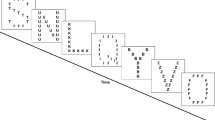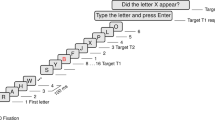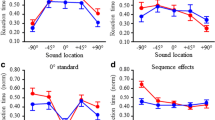Abstract
Our ability to allocate attention at different moments in time can sometimes fail to select stimuli occurring in close succession, preventing visual information from reaching awareness. This so-called attentional blink (AB) occurs when the second of two targets (T2) is presented closely after the first (T1) in a rapid serial visual presentation (RSVP). We hypothesized that entrainment to a rhythmic stream of stimuli—before visual targets appear—would reduce the AB. Experiment 1 tested the effect of auditory entrainment by presenting sounds with a regular or irregular interstimulus interval prior to a RSVP where T1 and T2 were separated by three possible lags (1, 3 and 8). Experiment 2 examined visual entrainment by presenting visual stimuli in place of auditory stimuli. Results revealed that irrespective of sensory modality, arrhythmic stimuli preceding the RSVP triggered an alerting effect that improved the T2 identification at lag 1, but impaired the recovery from the AB at lag 8. Importantly, only auditory rhythmic entrainment was effective in reducing the AB at lag 3. Our findings demonstrate that manipulating the pre-stimulus condition can reduce deficits in temporal attention characterizing the human cognitive architecture, suggesting innovative trainings for acquired and neurodevelopmental disorders.




Similar content being viewed by others
References
Akyürek, E. G., Riddell, P. M., Toffanin, P., & Hommel, B. (2007). Adaptive control of event integration: evidence from event-related potentials. Psychophysiology, 44(3), 383–391.
Akyürek, E. G., Toffanin, P., & Hommel, B. (2008). Adaptive control of event integration. Journal of Experimental Psychology: Human Perception and Performance, 34(3), 569.
Arend, I., Johnston, S., & Shapiro, K. (2006). Task-irrelevant visual motion and flicker attenuate the attentional blink. Psychonomic Bulletin & Review, 13(4), 600–607.
Arnell, K. M., & Jolicœur, P. (1999). The attentional blink across stimulus modalities: evidence for central processing limitations. Journal of Experimental Psychology: Human Perception and Performance, 25(3), 630–648.
Badcock, N. A., Badcock, D. R., Fletcher, J., & Hogben, J. (2013). The role of preparation time in the attentional blink. Vision Research, 76, 68–76.
Badcock, N. A., & Kidd, J. C. (2015). Temporal variability predicts the magnitude of between-group attentional blink differences in developmental dyslexia: a meta-analysis. PeerJ, 3, e746.
Besle, J., Schevon, C. A., Mehta, A. D., Lakatos, P., Goodman, R. R., McKhann, G. M., & Schroeder, C. E. (2011). Tuning of the human neocortex to the temporal dynamics of attended events. The Journal of Neuroscience, 31(9), 3176–3185.
Bolger, D., Trost, W., & Schön, D. (2013). Rhythm implicitly affects temporal orienting of attention across modalities. Acta Psychologica, 142(2), 238–244.
Buchholz, J., & Aimola Davies, A. (2007). Attentional blink deficits observed in dyslexia depend on task demands. Vision Research, 47(10), 1292–1302.
Calderone, D. J., Lakatos, P., Butler, P. D., & Castellanos, F. X. (2014). Entrainment of neural oscillations as a modifiable substrate of attention. Trends in Cognitive Sciences, 18(6), 300–309.
Carr, K. W., White-Schwoch, T., Tierney, A. T., Strait, D. L., & Kraus, N. (2014). Beat synchronization predicts neural speech encoding and reading readiness in preschoolers. Proceedings of the National Academy of Sciences, 111(40), 14559–14564.
Cohen, M. A., Cavanagh, P., Chun, M. M., & Nakayama, K. (2012). The attentional requirements of consciousness. Trends in Cognitive Sciences, 16(8), 411–417.
Dispaldro, M., Leonard, L. B., Corradi, N., Ruffino, M., Bronte, T., & Facoetti, A. (2012). Visual attentional engagement deficits in children with specific language impairment and their role in real-time language processing. Cortex,. doi:10.1016/j.cortex.2012.09.012.
Driver, J., & Spence, C. (1998). Attention and the crossmodal construction of space. Trends in Cognitive Sciences, 2(7), 254–262.
Dux, P. E., & Marois, R. (2009). The attentional blink: a review of data and theory. Attention, Perception, & Psychophysics, 71(8), 1683–1700.
Enns, J. T., & Di Lollo, V. (2000). What’s new in visual masking? Trends in Cognitive Sciences, 4(9), 345–352.
Facoetti, A., Ruffino, M., Peru, A., Paganoni, P., & Chelazzi, L. (2008). Sluggish engagement and disengagement of non-spatial attention in dyslexic children. Cortex, 44(9), 1221–1233.
Fiebelkorn, I. C., Foxe, J. J., Butler, J. S., Mercier, M. R., Snyder, A. C., & Molholm, S. (2011). Ready, set, reset: stimulus-locked periodicity in behavioral performance demonstrates the consequences of cross-sensory phase reset. The Journal of Neuroscience, 31(27), 9971–9981.
Gazzaley, A., & Nobre, A. C. (2012). Top-down modulation: bridging selective attention and working memory. Trends in Cognitive Sciences, 16(2), 129–135.
Geerligs, L., & Akyürek, E. G. (2012). Temporal integration depends on increased prestimulus beta band power. Psychophysiology, 49(11), 1632–1635.
Geiger, G., Cattaneo, C., Galli, R., Pozzoli, U., Lorusso, M. L., Facoetti, A., & Molteni, M. (2008). Wide and diffuse perceptual modes characterize dyslexics in vision and audition. Perception, 37(11), 1745–1764.
Glenberg, A. M., & Jona, M. (1991). Temporal coding in rhythm tasks revealed by modality effects. Memory & Cognition, 19(5), 514–522.
Goswami, U. (2011). A temporal sampling framework for developmental dyslexia. Trends in Cognitive Sciences, 15(1), 3–10.
Grahn, J. A. (2012). See what I hear? Beat perception in auditory and visual rhythms. Experimental Brain Research, 220(1), 51–61.
Gross, J., Schmitz, F., Schnitzler, I., Kessler, K., Shapiro, K., Hommel, B., & Schnitzler, A. (2006). Anticipatory control of long-range phase synchronization. European Journal of Neuroscience, 24(7), 2057–2060.
Guttman, S. E., Gilroy, L. A., & Blake, R. (2005). Hearing what the eyes see auditory encoding of visual temporal sequences. Psychological Science, 16(3), 228–235.
Handel, S., & Buffardi, L. (1969). Using several modalities to perceive one temporal pattern. The Quarterly Journal of Experimental Psychology, 21(3), 256–266.
Hanslmayr, S., Gross, J., Klimesch, W., & Shapiro, K. L. (2011). The role of alpha oscillations in temporal attention. Brain Research Reviews, 67(1), 331–343.
Hari, R., Valta, M., & Uutela, K. (1999). Prolonged attentional dwell time in dyslexic adults. Neuroscience Letters, 271(3), 202–204.
Husain, M., Shapiro, K., Martin, J., & Kennard, C. (1997). Abnormal temporal dynamics of visual attention in spatial neglect patients. Nature, 385(6612), 154–156.
Janson, J., & Kranczioch, C. (2011). Good vibrations, bad vibrations: oscillatory brain activity in the attentional blink. Advances in Cognitive Psychology, 7, 92–107.
Jones, M. R. (1976). Time, our lost dimension: Toward a new theory of perception, attention, and memory. Psychological review, 83(5), 323–355.
Jones, M. R., & Boltz, M. (1989). Dynamic attending and responses to time. Psychological review, 96(3), 459–491.
Jones, M. R., Boltz, M., & Kidd, G. (1982). Controlled attending as a function of melodic and temporal context. Perception and Psychophysics, 32(3), 211–218.
Jones, M. R., Moynihan, H., MacKenzie, N., & Puente, J. (2002). Temporal aspects of stimulus-driven attending in dynamic arrays. Psychological Science, 13(4), 313–319.
Jones, M. R., & Yee, W. (1997). Sensitivity to time change: the role of context and skill. Journal of Experimental Psychology: Human Perception and Performance, 23(3), 693–709.
Keysers, C., & Perrett, D. I. (2002). Visual masking and RSVP reveal neural competition. Trends in Cognitive Sciences, 6(3), 120–125.
Kim, C., & Blake, R. (2005). Psychophysical magic: rendering the visible ‘invisible’. Trends in Cognitive Sciences, 9(8), 381–388.
Kranczioch, C., Debener, S., Maye, A., & Engel, A. K. (2007). Temporal dynamics of access to consciousness in the attentional blink. Neuroimage, 37(3), 947–955.
Kranczioch, C., Debener, S., Schwarzbach, J., Goebel, R., & Engel, A. K. (2005). Neural correlates of conscious perception in the attentional blink. Neuroimage, 24(3), 704–714.
Lacroix, G. L., Constantinescu, I., Cousineau, D., de Almeida, R. G., Segalowitz, N., & von Grünau, M. (2005). Attentional blink differences between adolescent dyslexic and normal readers. Brain and Cognition, 57(2), 115–119.
Lakatos, P., Karmos, G., Mehta, A. D., Ulbert, I., & Schroeder, C. E. (2008). Entrainment of neuronal oscillations as a mechanism of attentional selection. Science, 320(5872), 110–113.
Lamme, V. A., Zipser, K., & Spekreijse, H. (2002). Masking interrupts figure-ground signals in V1. Journal of Cognitive Neuroscience, 14(7), 1044–1053.
Lapointe-Goupil, R., Fortin, C., Brisson, B., & Tremblay, S. (2011). Concurrency benefits in the attentional blink: attentional flexibility and shifts of decision criteria. Attention, Perception, & Psychophysics, 2, 374–388.
Large, E. W., & Jones, M. R. (1999). The dynamics of attending: How people track time-varying events. Psychological Review, 106(1), 119–159.
Lum, J. A. G., Conti-Ramsden, G., & Lindell, A. K. (2007). The attentional blink reveals sluggish attentional shifting in adolescents with specific language impairment. Brain and Cognition, 63(3), 287–295.
MacLean, M. H., & Arnell, K. M. (2011). Greater attentional blink magnitude is associated with higher levels of anticipatory attention as measured by alpha event-related desynchronization (ERD). Brain Research, 1387, 99–107.
Marois, R., Chun, M. M., & Gore, J. C. (2000). Neural correlates of the attentional blink. Neuron, 28(1), 299–308.
Martens, S., & Johnson, A. (2005). Timing attention: cuing target onset interval attenuates the attentional blink. Memory & Cognition, 33(2), 234–240.
Martens, S., & Wyble, B. (2010). The attentional blink: past, present, and future of a blind spot in perceptual awareness. Neuroscience and Biobehavioral Reviews, 34(6), 947–957.
Martin, E. W., Enns, J. T., & Shapiro, K. L. (2011). Turning the attentional blink on and off: opposing effects of spatial and temporal noise. Psychonomic Bulletin & Review, 18(2), 295–301.
Mathewson, K. E., Fabiani, M., Gratton, G., Beck, D. M., & Lleras, A. (2010). Rescuing stimuli from invisibility: inducing a momentary release from visual masking with pre-target entrainment. Cognition, 115(1), 186–191.
McAuley, J. D., & Jones, M. R. (2003). Modeling effects of rhythmic context on perceived duration: a comparison of interval and entrainment approaches to short-interval timing. Journal of Experimental Psychology-Human Perception and Performance, 29(6), 1102–1125.
Mercier, M. R., Foxe, J. J., Fiebelkorn, I. C., Butler, J. S., Schwartz, T. H., & Molholm, S. (2013). Auditory-driven phase reset in visual cortex: human electrocorticography reveals mechanisms of early multisensory integration. Neuroimage, 79, 19–29.
Miller, J. E., Carlson, L. A., & McAuley, J. D. (2013). When what you hear influences when you see: listening to an auditory rhythm influences the temporal allocation of visual attention. Psychological Science, 24(1), 11–18.
Nieuwenstein, M. R., Johnson, A., Kanai, R., & Martens, S. (2007). Cross-task repetition amnesia: impaired recall of RSVP targets held in memory for a secondary task. Acta Psychologica, 125(3), 319–333.
Olivers, C. N. L., & Nieuwenhuis, S. (2005). The beneficial effect of concurrent task-irrelevant mental activity on temporal attention. Psychological Science, 16(4), 265–269.
Pincham, H. L., & Szűcs, D. (2012). Conscious access is linked to ongoing brain state: electrophysiological evidence from the attentional blink. Cerebral Cortex, 22(10), 2346–2353.
Przybylski, L., Bedoin, N., Krifi-Papoz, S., Herbillon, V., Roch, D., Léculier, L., … Tillmann, B. (2013). Rhythmic auditory stimulation influences syntactic processing in children with developmental language disorders. Neuropsychology, 27(1), 121–131.
Raymond, J. E., Shapiro, K. L., & Arnell, K. M. (1992). Temporary suppression of visual processing in an RSVP task: an attentional blink. Journal of Experimental Psychology: Human Perception and Performance, 18(3), 849–860.
Reedijk, S. A., Bolders, A., Colzato, L. S., & Hommel, B. (2015). Eliminating the attentional blink through binaural beats: a case for tailored cognitive enhancement. Frontiers in Psychiatry, 6, 82.
Repp, B. H., & Penel, A. (2004). Rhythmic movement is attracted more strongly to auditory than to visual rhythms. Psychological Research, 68(4), 252–270.
Ruffino, M., Trussardi, A. N., Gori, S., Finzi, A., Giovagnoli, S., Menghini, D., & Facoetti, A. (2010). Attentional engagement deficits in dyslexic children. Neuropsychologia, 48(13), 3793–3801.
Schroeder, C. E., & Lakatos, P. (2009). Low-frequency neuronal oscillations as instruments of sensory selection. Trends in Neurosciences, 32(1), 9–18.
Shapiro, K. L., Raymond, J., & Arnell, K. (2002). The attentional blink. Trends in Cognitive Sciences, 1(8), 291–296.
Stefanics, G., Hangya, B., Hernádi, I., Winkler, I., Lakatos, P., & Ulbert, I. (2010). Phase entrainment of human delta oscillations can mediate the effects of expectation on reaction speed. The Journal of Neuroscience, 30(41), 13578–13585.
Tang, M. F., Badcock, D. R., & Visser, T. A. (2014). Training and the attentional blink: limits overcome or expectations raised? Psychonomic Bulletin & Review, 21(2), 406–411.
Thut, G., Miniussi, C., & Gross, J. (2012). The functional importance of rhythmic activity in the brain. Current Biology, 22(16), 658–663.
Visser, T. A., Boden, C., & Giaschi, D. E. (2004). Children with dyslexia: evidence for visual attention deficits in perception of rapid sequences of objects. Vision Research, 44(21), 2521–2535.
Vroomen, J., & de Gelder, B. (2004). Temporal ventriloquism: sound modulates the flash-lag effect. Journal of Experimental Psychology: Human Perception and Performance, 30(3), 513–518.
Zauner, A., Fellinger, R., Gross, J., Hanslmayr, S., Shapiro, K., Gruber, W., & Klimesch, W. (2012). Alpha entrainment is responsible for the attentional blink phenomenon. NeuroImage, 63(2), 674–686.
Acknowledgments
We are thankful to Roberto Dell’Acqua and Elkan Akyürek for their helpful comments on an earlier version of this manuscript. This work was supported by UK Medical Research Council grant G90951 (DS).
Author information
Authors and Affiliations
Corresponding author
Ethics declarations
Conflict of interest
Authors declare no conflict of interest.
Rights and permissions
About this article
Cite this article
Ronconi, L., Pincham, H.L., Szűcs, D. et al. Inducing attention not to blink: auditory entrainment improves conscious visual processing. Psychological Research 80, 774–784 (2016). https://doi.org/10.1007/s00426-015-0691-8
Received:
Accepted:
Published:
Issue Date:
DOI: https://doi.org/10.1007/s00426-015-0691-8




